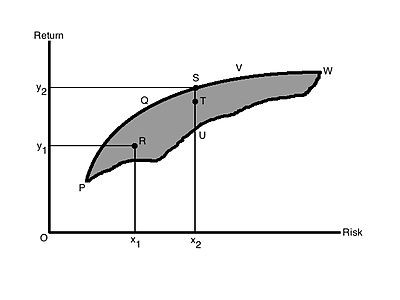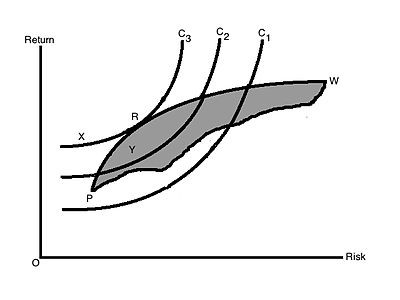Postmodern portfolio theory Wikipedia the free encyclopedia
Post on: 16 Март, 2015 No Comment

Contents
History [ edit ]
The term post-modern portfolio theory was created in 1991 by software entrepreneurs Brian M. Rom and Kathleen Ferguson to differentiate the portfolio-construction software developed by their company, Investment Technologies from those provided by the traditional Modern Portfolio Theory. It first appeared in the literature in 1993 in an article by Rom and Ferguson in The Journal of Performance Measurement. It combines the theoretical research of many authors and has expanded over several decades as academics at universities in many countries tested these theories to determine whether or not they had merit. The essential difference between PMPT and the modern portfolio theory of Markowitz and Sharpe (MPT) is that PMPT focuses on the return that must be earned on the assets in a portfolio in order to meet some future payout. This internal rate of return (IRR) is the link between assets and liabilities. PMPT measures risk and reward relative to this IRR while MPT ignores this IRR and measures risk as dispersion about the mean or average return. The result is substantially different portfolio constructions.
Empirical investigations began in 1981 at the Pension Research Institute (PRI) at San Francisco State University. Dr. Hal Forsey and Dr. Frank Sortino were trying to apply Peter Fishburn’s theory published in 1977 to Pension Fund Management. The result was an asset allocation model that PRI licensed Brian Rom to market in 1988. Mr. Rom coined the term PMPT and began using it to market portfolio optimization and performance measurement software developed by his company. These systems were built on the PRI downside risk algorithms. Sortino and Steven Satchell at Cambridge University co-authored the first book on PMPT. This was intended as a graduate seminar text in portfolio management. A more recent book by Sortino was written for practitioners. The first publication in a major journal was co-authored by Sortino and Dr. Robert van der Meer, then at Shell Oil Netherlands. The concept was popularized by numerous articles by Sortino in Pensions and Investments magazine and Dr. Sortino’s Blog: www.pmpt.me.
Sortino claims the major contributors to the underlying theory are:
• Peter Fishburn at the University of Pennsylvania who developed the mathematical equations for calculating downside risk and provided proofs that the Markowitz model was a subset of a richer framework.
• Atchison & Brown at Cambridge University who developed the three parameter lognormal distribution which was a more robust model of the pattern of returns than the bell shaped distribution of MPT.
• Bradley Efron, Stanford University, who developed the bootstrap procedure for better describing the nature of uncertainty in financial markets.
• William Sharpe at Stanford University who developed returns-based style analysis that allowed more accurate estimates of risk and return.
• Daniel Kahneman at Princeton & Amos Tversky at Stanford who pioneered the field of behavioral finance which contests many of the findings of MPT.
Overview [ edit ]
Harry Markowitz laid the foundations of MPT, the greatest contribution of which is [ citation needed ] the establishment of a formal risk/return framework for investment decision-making. By defining investment risk in quantitative terms, Markowitz gave investors a mathematical approach to asset-selection and portfolio management. But there are important limitations to the original MPT formulation.
Two major limitations of MPT are its assumptions that
- the variance [ 2 ] of portfolio returns is the correct measure of investment risk, and
- the investment returns of all securities and portfolios can be adequately represented by a joint elliptical distribution. such as the normal distribution .
Stated another way, MPT is limited by measures of risk and return that do not always represent the realities of the investment markets.
The assumption of a normal distribution is a major practical limitation, because it is symmetrical. Using the variance (or its square root, the standard deviation) implies that uncertainty about better-than-expected returns is equally averred as uncertainty about returns that are worse than expected. Furthermore, using the normal distribution to model the pattern of investment returns makes investment results with more upside than downside returns appear more risky than they really are. The converse distortion applies to distributions with a predominance of downside returns. The result is that using traditional MPT techniques for measuring investment portfolio construction and evaluation frequently does not accurately model investment reality.
It has long been recognized that investors typically do not view as risky those returns above the minimum they must earn in order to achieve their investment objectives. They believe that risk has to do with the bad outcomes (i.e. returns below a required target), not the good outcomes (i.e. returns in excess of the target) and that losses weigh more heavily than gains. This view has been noted by researchers in finance, economics and psychology, including Sharpe (1964). Under certain conditions the MVA can be shown to lead to unsatisfactory predictions of (investor) behavior. Markowitz suggests that a model based on the semivariance would be preferable; in light of the formidable computational problems. however, he bases his (MV) analysis on the mean and the standard deviation. [ 3 ]
Recent advances in portfolio and financial theory, coupled with increased computing power, have overcome these limitations. The resulting expanded risk/return paradigm is known as Post-Modern Portfolio Theory, or PMPT. Thus, MPT becomes nothing more than a special (symmetrical) case of PMPT.
The Tools of PMPT [ edit ]
In 1987 The Pension Research Institute at San Francisco State University developed the practical mathematical algorithms of PMPT that are in use today. These methods provide a framework that recognizes investors’ preferences for upside over downside volatility. At the same time, a more robust model for the pattern of investment returns, the three-parameter lognormal distribution. [ 4 ] was introduced.
Downside risk [ edit ]
Downside risk (DR) is measured by target semi-deviation (the square root of target semivariance) and is termed downside deviation. It is expressed in percentages and therefore allows for rankings in the same way as standard deviation .
An intuitive way to view downside risk is the annualized standard deviation of returns below the target. Another is the square root of the probability-weighted squared below-target returns. The squaring of the below-target returns has the effect of penalizing failures quadratically. This is consistent with observations made on the behavior of individual decision-making under
where

d = downside deviation (commonly known in the financial community as ‘downside risk’). Note: By extension, d ² = downside variance.
t = the annual target return, originally termed the minimum acceptable return, or MAR.
r = the random variable representing the return for the distribution of annual returns f (r ),
f (r ) = the distribution for the annual returns, e.g. the three-parameter lognormal distribution
For the reasons provided below, this continuous formula is preferred over a simpler discrete version that determines the standard deviation of below-target periodic returns taken from the return series.
1. The continuous form permits all subsequent calculations to be made using annual returns which is the natural way for investors to specify their investment goals. The discrete form requires monthly returns for there to be sufficient data points to make a meaningful calculation, which in turn requires converting the annual target into a monthly target. This significantly affects the amount of risk that is identified. For example, a goal of earning 1% in every month of one year results in a greater risk than the seemingly equivalent goal of earning 12% in one year.
2. A second reason for strongly preferring the continuous form to the discrete form has been proposed by Sortino & Forsey (1996):
Before we make an investment, we don’t know what the outcome will be. After the investment is made, and we want to measure its performance, all we know is what the outcome was, not what it could have been. To cope with this uncertainty, we assume that a reasonable estimate of the range of possible returns, as well as the probabilities associated with estimation of those returns. In statistical terms, the shape of [this] uncertainty is called a probability distribution. In other words, looking at just the discrete monthly or annual values does not tell the whole story.
Using the observed points to create a distribution is a staple of conventional performance measurement. For example, monthly returns are used to calculate a fund’s mean and standard deviation. Using these values and the properties of the normal distribution, we can make statements such as the likelihood of losing money (even though no negative returns may actually have been observed), or the range within which two-thirds of all returns lies (even though the specific returns identifying this range have not necessarily occurred). Our ability to make these statements comes from the process of assuming the continuous form of the normal distribution and certain of its well-known properties.
In PMPT an analogous process is followed:
- Observe the monthly returns,
- Fit a distribution that permits asymmetry to the observations,
- Annualize the monthly returns, making sure the shape characteristics of the distribution are retained,
- Apply integral calculus to the resultant distribution to calculate the appropriate statistics.
Sortino ratio [ edit ]
The Sortino ratio. developed by Rom’s company, Investment Technologies, was the first new element in the PMPT rubric. It was designed to replace MPT’s Sharpe ratio as a measure or risk-adjusted return. It is defined as:
where
r = the annualized rate of return,
t = the target return,
The following table shows that this ratio is demonstrably superior to the traditional Sharpe ratio as a means for ranking investment results. The table shows risk-adjusted ratios for several major indexes using both Sortino and Sharpe ratios. The data cover the five years 1992-1996 and are based on monthly total returns. The Sortino ratio is calculated against a 9.0% target.














